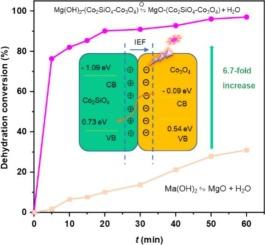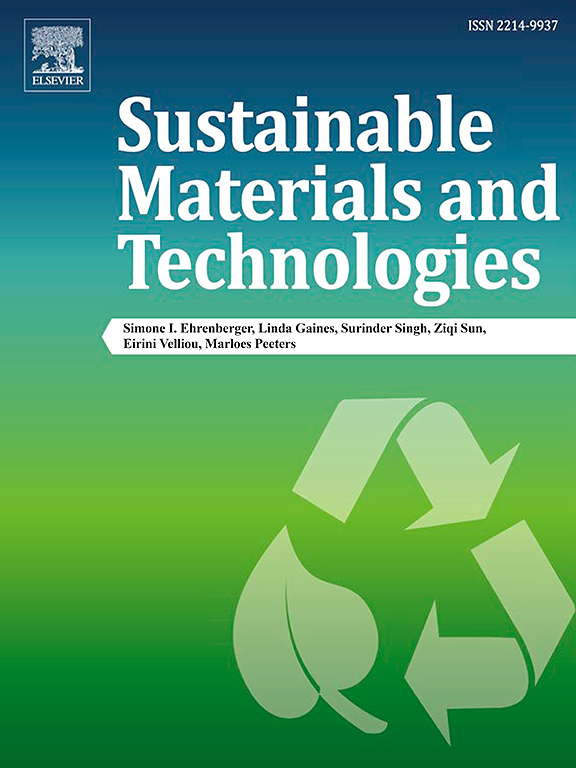利用界面结和 Mg(OH)2-(Co2SiO4-Co3O4)的直接光热储能技术异常提高硅酸盐的吸收率
IF 8.6
2区 工程技术
Q1 ENERGY & FUELS
引用次数: 0
摘要
近红外(NIR)光的吸收对于有效利用光热太阳能至关重要,而这是通过高密度自由电荷载流子(FCC)的表面等离子体共振实现的。在此,我们证明了 S 型界面结 (IJ) 可以大幅提高 FCC 密度,并增强硅酸盐从紫外到近红外区域的吸收。我们在片状 Co3O4-Co2SiO4 纳米粒子中构建了大量具有 S 型结构的 p-n IJ,从而极大地增强了整个太阳光谱的光吸收能力。此外,这种吸收剂还能通过 Mg(OH)2-(Co3O4-Co2SiO4)复合材料的混合物改善 Mg(OH)2 的光热性能。在 30 分钟的辐照条件下,该混合物中 Mg(OH)2 的光热脱水转化率显著提高了 6.7 倍。Mg(OH)2 光热水合-脱水循环的可逆性提高了 18.3 倍,并且通过降低脱水活化能(降低了 25.4%),热储存动力学得到了显著改善。结果表明,Mg(OH)2-Co3O4-Co2SiO4 是光热转换和能量存储一步法系统的理想候选材料。本文章由计算机程序翻译,如有差异,请以英文原文为准。

Exceptionally boosted absorption of silicates by interfacial junctions and direct light–heat–energy storage using Mg(OH)2–(Co2SiO4–Co3O4)
Near-infrared (NIR) light absorption is essential for the effective utilization of photothermal solar energy, which is realized via the surface plasmon resonance of a high density of free charge carriers (FCCs). Herein, we demonstrate that S-scheme interfacial junctions (IJs) can substantially increase the FCC density and intensify absorption of silicates from the ultraviolet to NIR region. Numerous p–n IJs with S-scheme types are constructed within sheet-like Co3O4–Co2SiO4 nanoparticles, exceptionally boosting the light absorption capability over the entire solar spectrum. Moreover, this absorber can improve the photothermal performance of Mg(OH)2 via a mixture of Mg(OH)2–(Co3O4–Co2SiO4) composite. The photothermal dehydration conversion of Mg(OH)2 in this mixture considerably improves by 6.7 times under 30-min irradiation. The reversibility of the photothermal hydration–dehydration cycles of Mg(OH)2 improves by 18.3 times, and the thermal storage kinetics substantially improves via the reduction of the activation energy of dehydration (reduction of 25.4 %). Results indicate that Mg(OH)2–Co3O4–Co2SiO4 is a promising candidate for a one-step system of photothermal conversion and energy storage.
求助全文
通过发布文献求助,成功后即可免费获取论文全文。
去求助
来源期刊

Sustainable Materials and Technologies
Energy-Renewable Energy, Sustainability and the Environment
CiteScore
13.40
自引率
4.20%
发文量
158
审稿时长
45 days
期刊介绍:
Sustainable Materials and Technologies (SM&T), an international, cross-disciplinary, fully open access journal published by Elsevier, focuses on original full-length research articles and reviews. It covers applied or fundamental science of nano-, micro-, meso-, and macro-scale aspects of materials and technologies for sustainable development. SM&T gives special attention to contributions that bridge the knowledge gap between materials and system designs.
 求助内容:
求助内容: 应助结果提醒方式:
应助结果提醒方式:


